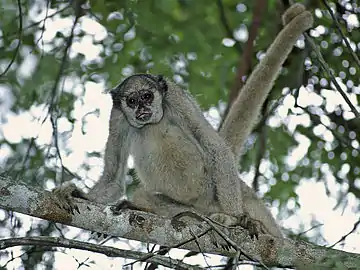Northern muriqui
The northern muriqui (Brachyteles hypoxanthus) is an endangered muriqui or woolly spider monkey species endemic to Brazil. It is unusual among primates in that it shows egaliterian social relationships.[3] It is found in the Atlantic Forest region of the Brazilian states of Rio de Janeiro, Espírito Santo, Minas Gerais and Bahia. Muriquis are the largest species of New World monkeys. The northern muriqui can grow up to 4.3 ft long. It feeds mainly on leaves and twigs, but will also eat fruit. It often hangs upside-down by its prehensile tail while eating.
| Northern muriqui[1] | |
|---|---|
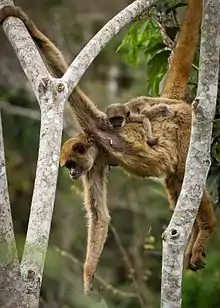 | |
| Female and infant, in Caratinga, Brazil. | |
| Scientific classification | |
| Kingdom: | Animalia |
| Phylum: | Chordata |
| Class: | Mammalia |
| Order: | Primates |
| Suborder: | Haplorhini |
| Infraorder: | Simiiformes |
| Family: | Atelidae |
| Genus: | Brachyteles |
| Species: | B. hypoxanthus |
| Binomial name | |
| Brachyteles hypoxanthus (Kuhl, 1820) | |
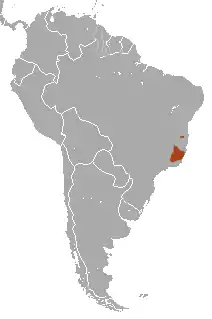 | |
| Northern muriqui range | |
Identification
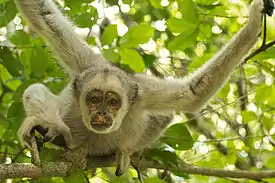
Northern muriquis can be individually recognized by their natural markings and facial features, such as fur color and patterning, ear shape, and face shape and pigmentation.[4] Their sex can usually be determined within a week or so of birth, based on the shape and positioning of their genitalia.[5] Female muriquis are more independent than males; they leave their natal groups at an age of about six years.[6] Female muriquis engage in sex with multiple partners, which may serve to confuse paternity, limit male aggression, or improve odds of fertilization.[7] Male muriquis have almost no interaction with infants. When there is an interaction between the two, the infant would be the one to initiate it.[8]
Endangered
B. hypoxanthus is one of the world's most critically endangered primates, according to the IUCN Red List of Threatened Species.[2] It is threatened by hunting and (in common with most other primates of the region) destruction and fragmentation of its Atlantic Forest habitat.[2] Among the scattered populations of northern muriqui only one population, living in Caratinga is considered, as of now, viable for the next 100 years.[9] The northern muriqui also suffers from very low genetic diversity[10] and is poorly understood, causing problems in conservation.[11] The estimated wild population of northern muriquis was raised from about 500 to 1000 individuals in 2005, due to new discoveries and research in other forests.[5]
Human evolution relevance
The northern muriqui has been argued to be important to understanding human evolution, since it is one of the few primates that has tolerant, nonhierarchial relationships among and between males and females, a feature shared with hunter-gatherer humans, but which contrasts with the ranked relationships of most other primates.[3] Group aggression is also rare.[3] The success of males fathering offspring links to the maternal investment they gain from their mothers and coresident female kin. This provides support to the grandmother hypothesis.[3]
See also
- Feliciano Miguel Abdala Private Natural Heritage Reserve, long thought to be the only place where these monkeys still survive
References
- Groves, C. P. (2005). "Order Primates". In Wilson, D. E.; Reeder, D. M (eds.). Mammal Species of the World: A Taxonomic and Geographic Reference (3rd ed.). Johns Hopkins University Press. p. 151. ISBN 978-0-8018-8221-0. OCLC 62265494.
- Ferraz, D. da S.; Tabacow, F.; Mittermeier, R.A.; Melo, F.; Boubli, J.; Jerusalinsky, L.; Talebi, M. (2019). "Brachyteles hypoxanthus". IUCN Red List of Threatened Species. 2019: e.T2994A17927482. Retrieved 7 March 2020.
- Strier, K.B., Chaves, P.B., Mendes, S.L., Fagundes, V., Di Fiore, A. (2011). Low paternity skew and the influence of maternal kin in an egalitarian, patrilocal primate, PNAS, 108, 18915–18919 doi:10.1073/pnas.1116737108
- Chaves, Paulo B.; Magnus, Tielli; Jerusalinsky, Leandro; Talebi, Maurício; Strier, Karen B.; Breves, Paula; Tabacow, Fernanda; Teixeira, Rodrigo H. F.; Moreira, Leandro; Hack, Robson O. E.; Milagres, Adriana; Pissinatti, Alcides; Melo, Fabiano R.; Pessutti, Cecília; Mendes, Sérgio L.; Margarido, Tereza C.; Fagundes, Valéria; Di Fiore, Anthony; Bonatto, Sandro L. (December 2019). "Phylogeographic evidence for two species of muriqui (genus Brachyteles )". American Journal of Primatology. 81 (12): e23066. doi:10.1002/ajp.23066. PMID 31736121. S2CID 182008678.
- Strier, Karen B, Jean P. Boubli, Carla B Possamai, and Se ́ rgio L. Mendes4. "Population Demography of Northern Muriquis (Brachyteles Hypoxanthus) at the Estac ̧ a ̃ O Biolo ́ Gica De Caratinga/Reserva Particular Do Patrimoˆ Nio Natural-Felı`ciano Miguel Abdala, Minas Gerais, Brazil."AMERICAN JOURNAL OF PHYSICAL ANTHROPOLOGY (2006): 1-3.
- Strier, KB, SL Mendes, and K. "Web of Knowledge [v5.6]." Genetic Diversity and Population History of a Critically Endangered Primate, the Northern Muriqui 17.2 (2011): 53-69. Web.
- Possami, Carla. "Socio-Sexual Behavior of Female Northern Muriquis." Socio-Sexual Behavior of Female Northern Muriquis 69.7 (2007). Web.
- Oliveria Guimaraes, Vanessa. "Adult Male-infant Interactions in Wild Muriquis (Brachyteles Arachnoides Hypoxanthus)." N.p., Oct. 2001. Web. 26 Oct. 2012.
- Brito, Daniel, and Carlos Eduardo V. Grelle. Estimating Minimum Area of Suitable Habitat and Viable Population Size for the Northern Muriqui. Pdfcast.org. Springer, n.d. Web. 26 Oct. 2012.http://pdfcast.org/pdf/estimating-minimum-area-of-suitable-habitat-and-viable-population-size-for-the-northern-muriqui-brac#>.
- Chaves, Paulo B.; Alvarenga, Clara S.; Possamai, Carla de B.; Dias, Luiz G.; Boubli, Jean P.; Strier, Karen B.; Mendes, Sérgio L.; Fagundes, Valéria (3 June 2011). "Genetic Diversity and Population History of a Critically Endangered Primate, the Northern Muriqui (Brachyteles hypoxanthus)". PLOS ONE. 6 (6): e20722. doi:10.1371/journal.pone.0020722. PMC 3108597. PMID 21694757.
- Daniel, Brito. "Lack of Adequate Taxonomic Knowledge May Hinder Endemic Mammal Conservation in the Brazilian Atlantic Forest." Google Scholar. N.p., 2004. Web. 26 Oct. 2012.
Gallery
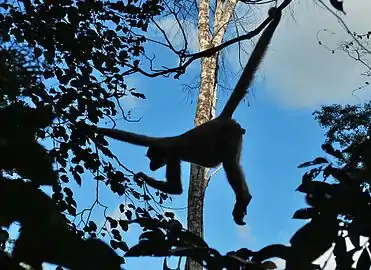 Silhouette of adult using its prehensile tail |
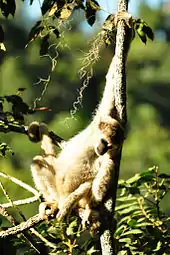 Sitting muriqui |
External links
| Wikispecies has information related to Northern Muriqui. |

